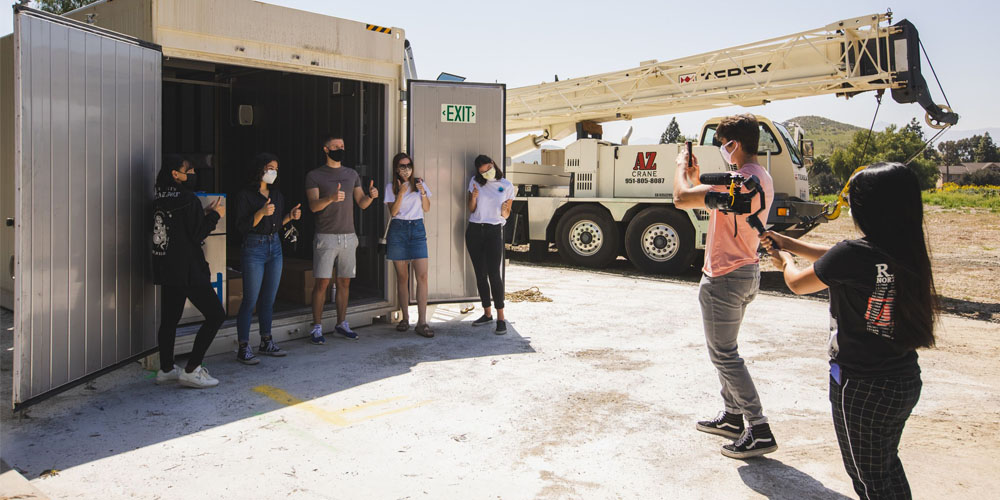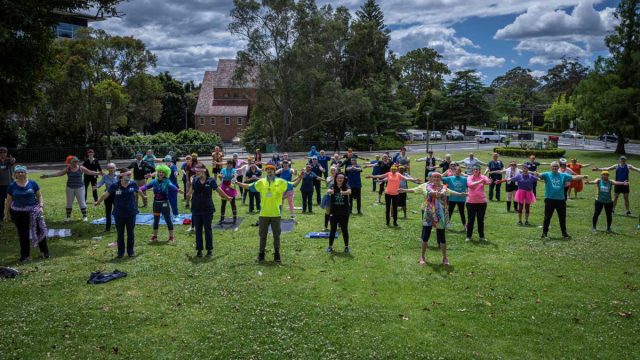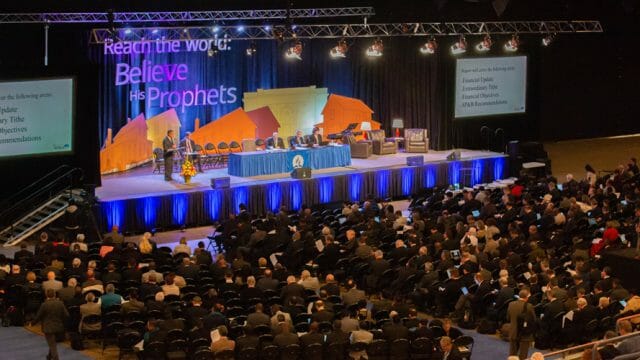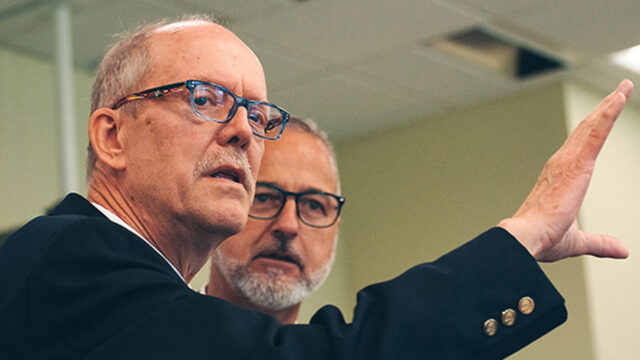Freight2Table recasts the Adventist school’s century-old tradition of farming.

During La Sierra University’s beginnings in the early 20th century, the school farm, especially its dairy, alfalfa fields, and watermelon patch, was a critical source of income for the institution and its student laborers. In 2021, farming returned to the campus in Riverside, California, United States — on a big rig.
During the 2019-2020 school year, the university’s student Enactus team based in the Zapara School of Business began work on its Freight2Table project through the Boston-based Freight Farms program. The project involves growing varieties of lettuce and leafy green vegetables, herbs, flowers, and roots inside a 40-foot shipping container repurposed and designed with hydroponics technology.
The Freight Farms container arrived on March 30, 2021, hoisted by a crane and set down on a slab of recycled concrete and asphalt. Three months later, the Enactus team harvested its first crops — approximately 540 heads of red leaf lettuce on July 12 and roughly 550 heads on July 19, a first bounty donated to campus and community members. The team also planted baby leaf lettuce, Swiss chard, and butter lettuce in various growth stages. The Enactus team aims to establish produce-supplier agreements with local businesses and organizations and is communicating with markets in Riverside and with the university’s Dining Commons.
The growing process involves a reverse osmosis water filtration system purchased and installed inside the container. A timed and regulated supply of electricity and nutrient-infused water along with growing lights for plant photosynthesis forms the basis for how the hydroponic farm operates. University faculty and staff oversee the system processes and container technology. Freight Farms in Boston has real-time virtual access to the container’s systems for providing assistance if needed. For students, the hydroponics farming venture has provided a plethora of learning opportunities, starting with an introduction to hydroponics agriculture.
“While I had heard that term thrown around in the past, I was never really quite sure what it meant, but after having spent so many hours tending to a hydroponic garden, I feel I have a pretty clear picture of how the whole system operates,” Aaron DesJardins, a dual marketing and graphic design major, who this year serves as the Enactus team’s marketing vice president, said. His efforts include designing the farm’s logo and branding as “Two-Bit’s Best,” in reference to the hill overlooking the university campus known as Two-Bit Mountain.
“Another big thing I’ve learned while working with the Freight2Table project has been the importance of coordination, communication, and team management,” DesJardins said. “There is a much higher likelihood that the crop will not turn out good if it is not managed correctly.”
Since May, DesJardins and his teammates have dedicated several hours each week working with crops in the container and in team meetings planning produce distribution. Inside the container, they wear masks for health and safety purposes, as well as gloves and protective lab coats, to reduce the risk of contamination to the plants and growing system.
Marvin Payne, associate biochemistry professor and project director for the Title V grant-funded Guided Pathways to Success program, and Richard Rakijian, summer program coordinator and chemistry/biochemistry lab manager, oversee the operations of the hydroponics farm. “Dr. Payne and Richard have been a huge help in being there to help us navigate the freight operations,” DesJardins said. “They have also been a big help in helping us decide which crops to plant and scheduling things such as harvests and transplant dates.”
The new Title V program, Guided Pathways to Success in STEM, incorporates STEM education into a summer curriculum designed to help incoming first-year students become inspired to pursue STEM degrees and succeed in college. Botanist and university biology professor John Perumal will lead activities in germinating seeds for experiments under different conditions and in plant growth and development assessments. The Enactus team has developed partnerships with other campus groups and programs, such as the Hispanic Business Incubator.
The Enactus Freight2Table project will also offer agricultural technology education to elementary students in local school districts.
With Freight2Table, the Enactus team is entering an agricultural technology market that is expected to grow substantially in coming years. Food producers are looking to feed the planet’s burgeoning population in more controlled and easily accessible ways in the face of extreme weather and drought, and as individual growers seek alternatives to traditional gardens. Hydroponics agriculture comprised about half of the vertical farming marketing in the U.S. in 2018, according to an industry outlook and forecast through Research and Markets in Dublin, Ireland. It is forecasted to grow 22 percent during the period of 2019 to 2024. The report states that the overall U.S. vertical farming market is projected to reach a value of around US$3 billion by 2024.
Hydroponic agriculture’s water-conserving process is an important consideration in drought-prone regions, including the western U.S. and, in particular, California, where a years-long, historic drought is stoking anxiety over water supplies. Hydroponic farming systems capture and re-use water, and as such, can use as much as 10 times less water than what is used with field crops, according to Powerhouse Hydroponics.
Currently, Enactus students are volunteering their time to establish and maintain Freight2Table. In the future, the team aims to hire students to manage the container farm as it increases production. The eight-week crop-growing process is labor intensive. During the first week, tiny seeds are planted by hand in small peat pods and then germinated in seedling trays in a top trough. In the second and third weeks, the germinates mature in the seedling trays in a bottom trough. During the fourth week, hundreds of juvenile plants are transplanted to vertical growing panels one at a time and left to grow and mature four to five weeks before harvesting. The moveable vertical growing panels, which occupy most of the shipping container space, provide four sides for growing plants, with each side accommodating between 576 and 990 plants, depending on the variety.
The hydroponics farming project and its results are included in the team’s Enactus annual report and multi-media presentation during annual Enactus competitions. Enactus, a global non-profit organization based in Springfield, Missouri, is focused on economic and educational empowerment through business innovation and collaboration. It has teams at 1,730 campuses in 36 countries. Since joining in 1991, the La Sierra team has won seven Enactus national championships and two world cups. During national competitions in April, which were held virtually, the La Sierra team placed among the top eight teams in the nation and received the Excellence in Project Management Award from the U.S. Enactus organization.
La Sierra Enactus member Max Proebstle will enter his second year of graduate study this fall and served as part of the presentation team this past school year during competitions. He is earning dual MBAs in health-care management and finance and has been involved in the hydroponics farm since October 2020. Going forward, he will work with other students in maintaining a steady flow of crops from the farm and building up its customer base.
“Before this project, I didn’t even know that hydroponics existed. So, everything has been relatively new for me. It’s been quite the experience learning how to grow plants in this way,” Proebstle said. “The hardest part is learning the system and then getting a feel for nutrient and pH levels. Another thing I’ve learned is that more people care about this form of sustainable farming and food production than I would have thought. We’ve gotten such great feedback from donors, sponsors, the school, and the community; it’s really been a blessing.”
The original version of this story was posted by La Sierra University.








